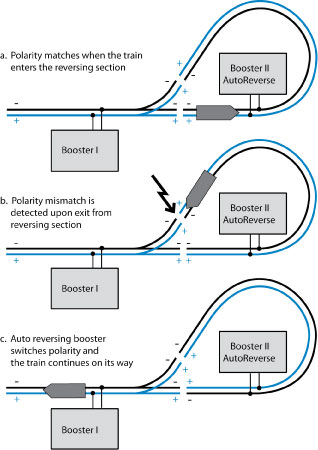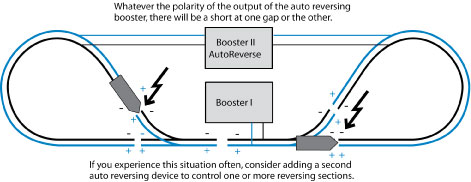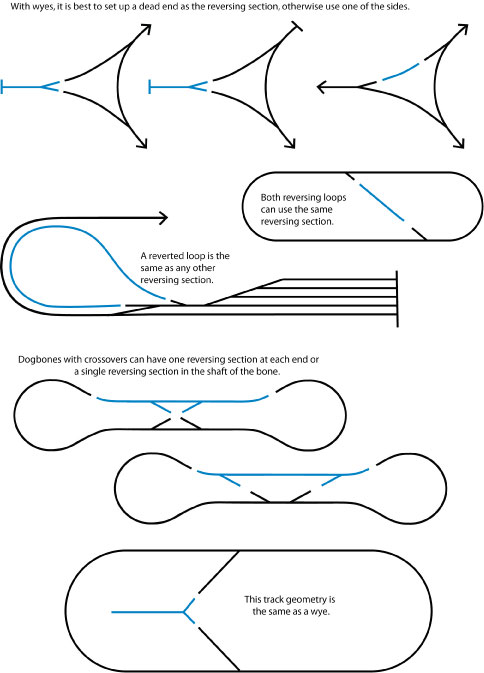DCC Automatic Reversing Sections
Virtually all automatic reversing will fall into 3 categories with the wiring principles for all being the same:
1. Reverse Loops
2. Wyes
3. Turntables
DCC has the ability to automatically reverse sections of track we call Reversing Sections while our trains are running and not affect the direction or speed of the trains. This is because we put a constant square wave AC current on the track and control the trains (locos) by sending messages to them (actually to receivers we call decoders) to tell them what to do such as start, stop, change directions, etc. . We are thus not controlling the trains by controlling the tracks as in DC by varying the voltage and polarity. If we tell our train to go “forward” at a certain speed it will do so without regard to the phasing (polarity if you will) of the track.
We have always had the ability to utilize reversing sections but have had to stop our trains and by using toggle switches, relays, etc. change the polarity of our DC layouts before continuing on through to the rest of the layout. Now thanks to the concept of DCC we can automate those reversing sections without ever having to stop the train. We now have the ability to have a true loop to loop layout and run trains without paying any attention to them and they will run continually with devices such as the Digitrax PM42 or AR1 keeping the phasing correct and detection devices as the BD4 or BDL168 coupled with stationary decoders like the DS64 throwing the switches (turnouts) the proper direction.
This example shows how auto-reversing units:
There are some basic fundamentals we must always follow for solid automatic reversing using Digitrax auto-reversing units.
The reversing section should if at all possible be longer than the longest train.
We must gap both rails at each end of our reversing section. This allows it to work autonomous from the tracks on each end and this is important as the reversing section will always be “out of phase” with the adjoining track on one end or the other. Both ends of the reversing section can never be “in phase” with the adjoining track. If they were there would be no need for the reversing section. 
The gaps must allow the metal wheels of the loco or rolling stock to touch the rails on both sides simultaneously to create a “hard” short when the rails are not in phase (Rail A on one side of the gap is now on the same side of the track as Rail B is on the other side of the gap). This means if we are using insulated rails joiners they must not come up to the top of the rail preventing the wheels from touching both sides of the gap and thus not allowing a good short to occur at that point. If we do not have a hard short the auto-reversing module cannot react and change the phase of the reversing section and the booster will generally shut down in self defense. If you are using the insulated rail joiners or styrene in the gaps lower it until you have at least 1/32” down from the top of the rail.
We must also have approximately the same amount of current on both sides of the gaps to get the proper shorting necessary for the AR1/PM42 to see the phase issue and react by changing the phasing of the reversing section. This means it is usually not a good idea to put your reversing section immediately behind the frog rails of a switch. It is better to cut your gaps several inches from the frog of the switch and have track feeds between the frog and gaps. Counting on the switch points to conduct enough current though to the gaps is always “iffy” at best.
The reversing section itself can only be powered by the auto-reversing unit and never from other sources such as your track buss. If it is long enough that you need more than one set of track feeders simply use the two wires from the auto-reversing unit and drop multiple track feeders to the auto-reversing unit’s buss.
The following are typical examples of reversing sections on layouts:
The bridge track is the reversing section of a turntable.
Information Originally Published In The Digitrax Big Book Of DCC